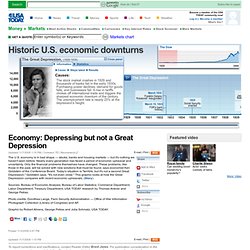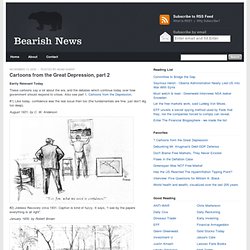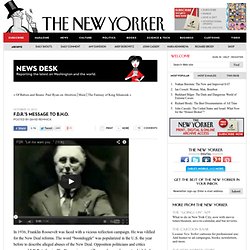

Stories from the Great Depression. Scenes from the Great Depression. The Crash of 1929 & The Great Depression (PBS) 1of6. Economy: Depressing but not a Great Depression. The U.S. economy is in bad shape — stocks, banks and housing markets — but it's nothing we haven't seen before.

Nearly every generation has faced a period of economic upheaval and uncertainty. Only the financial problems themselves have changed. These problems, like those in the past, will be solved with new solutions that must be found, says economist Ken Goldstein of the Conference Board. Today's situation is "terrible, but it's not a second Great Depression," Goldstein says. "It's not even close. " Sources: Bureau of Economic Analysis; Bureau of Labor Statistics; Commerce Department; Labor Department; Treasury Department; USA TODAY research by Thomas Ankner and George Petras.
Photo credits: Dorothea Lange, Farm Security Administration — Office of War Information Photograph Collection (Library of Congress) and AP. Graphic by Robert Ahrens, George Petras and Julia Schmalz, USA TODAY. Guidelines: You share in the USA TODAY community, so please keep your comments smart and civil. Political Cartoons from the Great Depression. Eerily Relevant Today These cartoons say a lot about the era, and the debates which continue today over how government should respond to crises.

Also see part 1, Cartoons from the Depression. #1) Like today, confidence was the real issue then too (the fundamentals are fine, just don’t dig too deep). August 1931, by C. W. . #2) Jobless Recovery circa 1931. January 1930, by Robert Brown #3) False “green shoots” in Fall of ’31 November 1931, by Robert Brown #4) 1933 – In a fit of insanity which lasted throughout much of the depression, the American government enacted the Agricultural Adjustment Act, which paid farmers to destroy food and plant less crops. June 1935, George Shellhase #5) Another critique of the AAA, this one from a leading black newspaper. May 1934, L. . #6) Broke but hoping. January 1931, by Ed Graham #7) Mixed signals. October 1931, John Cassel #8) Santa gets jacked. December 1931, Ralph Fuller. What caused the Dust Bowl?" When pioneers headed west in the late 19th century, many couldn't resist the lure of the tall grassy land in the semiarid midwestern and southern plains of the United States.

They settled there to farm. They were prosperous in the decades that followed, but when the 1930s rolled in, so did strong winds, drought and clouds of dust that plagued nearly 75 percent of the United States between 1931 and 1939 [source: PBS]. FDR Inaugurated! 1st Sound Pics of an Inauguration 1933/3/5. Roosevelt's Message to Obama. In 1936, Franklin Roosevelt was faced with a vicious reëlection campaign.

He was vilified for the New Deal reforms. The word “boondoggle” was popularized in the U.S. the year before to describe alleged abuses of the New Deal. Opposition politicians and critics compared F.D.R. to Lenin. The Depression was still on, and unemployment, which had dropped significantly, was still high, over fourteen per cent. (It would rise again in 1938.) Let me warn you and let me warn the nation against the smooth evasion which says, “Of course we believe all these things; we believe in social security; we believe in work for the unemployed; we believe in saving homes. The video of the Syracuse speech has been kicking around—you’ve got to watch it; F.D.R. is sharp, funny, and masterful—and the full text is well worth reading, too. Franklin D. Roosevelt Presidential Library and Museum - Featured Topic: "Second Bill of Rights," FDR's 1944 State of the Union Address.
Franklin Roosevelt -Second Bill of Rights. New Deal Acronyms. HSTAA 101: New Deal Agencies. Below is a partial list of New Deal "alphabet agencies" and their primary function (relief, recovery, or reform).

AGRICULTURAL ADJUSTMENT ACT (Recovery) Created in 1933, he AAA paid farmers for not planting crops in order to reduce surpluses, increase demand for seven major farm commodities, and raise prices. Farm income rose, but many tenants and share-croppers were pushed into the ranks of the unemployed. In 1936 the Supreme Court voided the AAA. CIVIL WORKS ADMINISTRATION (Relief) Created in 1933, the CWA employed four million people--paid an average of $15 a week--many in useful construction jobs such as repairing schools, laying sewer pipes, building roads.
Some CWA jobs, however, were criticized as useless (e.g., leaf raking). disbanded the program after less than a year. FARM SECURITY ADMINISTRATION (Relief) The FSA was created in 1937 (formerly called the Resettlement Administration in 1935) to aid sharecroppers. FEDERAL DEPOSIT INSURANCE CORP. FEDERAL EMERGENCY RELIEF ADMIN. New Deal Acronyms flashcards. Franklin D. Roosevelt Presidential Library and Museum - Periodic Table of the New Deal. New Deal Network. Let Us Now Praise Walker Evans.